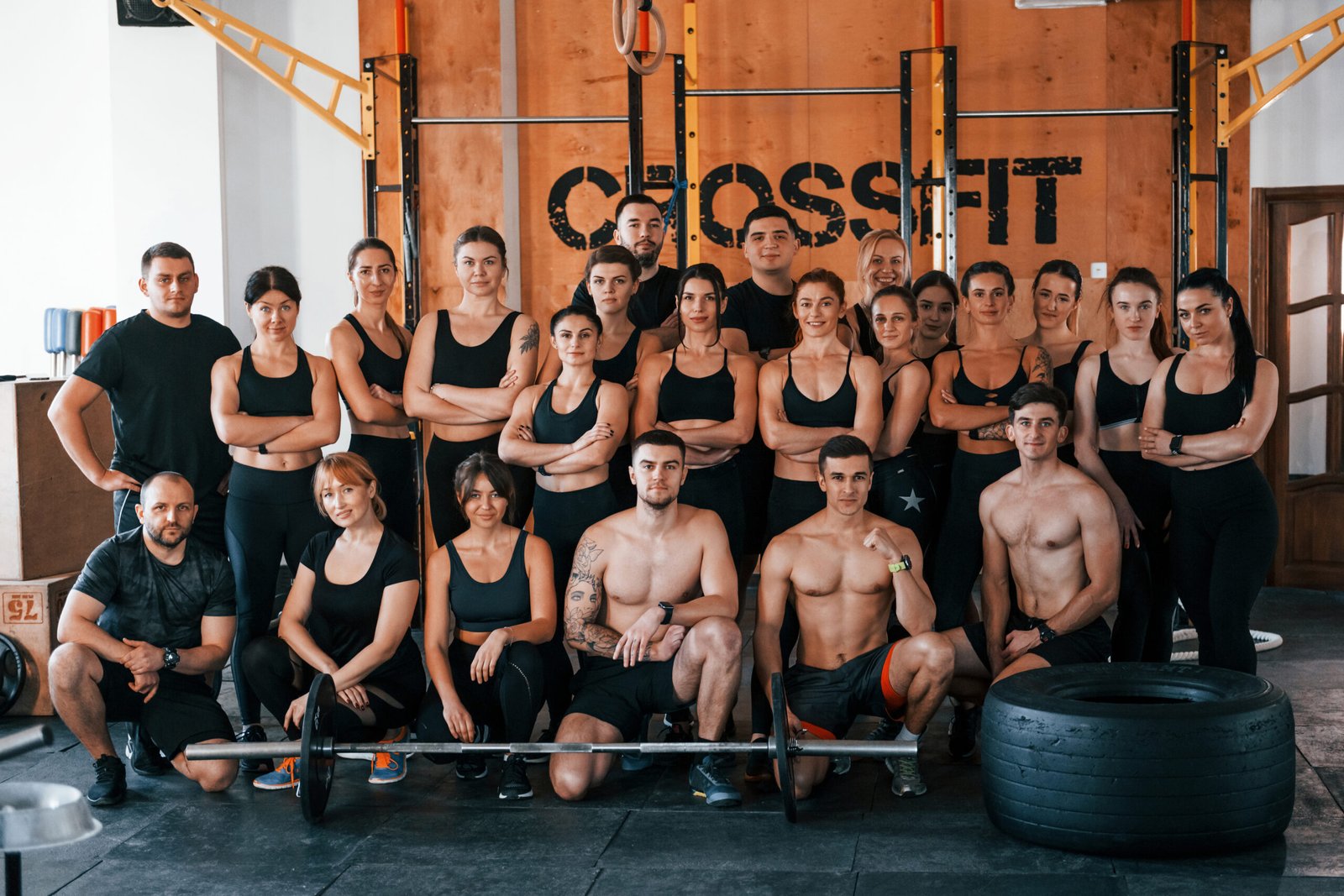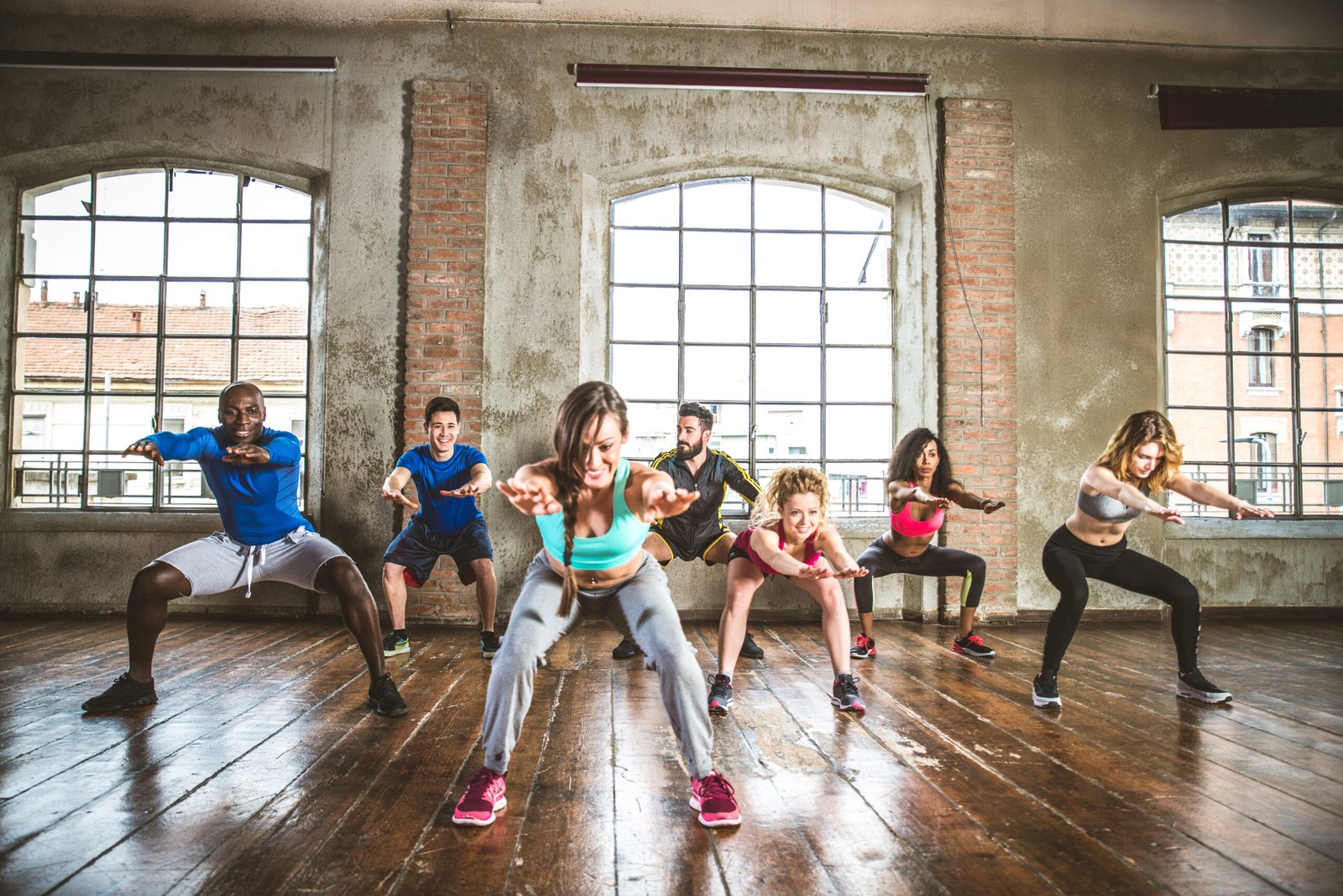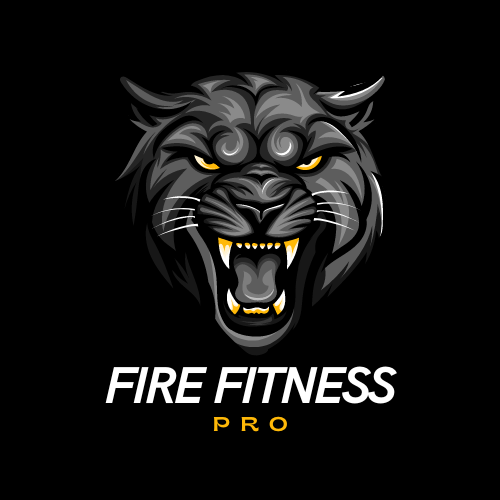In the dynamic world of CrossFit, “Customizing CrossFit Workouts for Different Fitness Levels” plays a crucial role in ensuring that every participant, whether a novice or a seasoned athlete, can benefit from the exercises. CrossFit’s appeal lies in its scalability, making it accessible to individuals across all fitness spectrums. This guide, “Unlock Your Fitness Potential: Expert Tips for Customizing CrossFit Workouts to Suit Every Fitness Level,” will explore how you can adapt your CrossFit routine to match your specific fitness level for optimal results.
The Art of Scaling: Adapting CrossFit Workouts to Your Fitness Level
Scaling CrossFit workouts is more than just adjusting exercises; it’s about tailoring your workout to suit your personal fitness journey. This approach ensures everyone can participate in CrossFit safely and effectively. Modifying workout components like intensity, volume, and skill level allows individuals to build strength and endurance progressively. By understanding and implementing scaling techniques, individuals can avoid injuries and enhance their personal progress within the CrossFit framework. Expert guidance plays a pivotal role in helping you identify suitable modifications and setting realistic fitness goals. Regular evaluations and adjustments to your workouts not only help track progress but also maintain motivation toward your fitness objectives. By mastering the art of scaling, you embark on a personalized fitness journey that aligns with your capabilities and aspirations.
– Adjust the intensity of exercises by reducing weights or reps.
– Modify complex movements to simpler alternatives.
– Gradually increase workout volume as your fitness improves.
– Seek personalized advice from certified CrossFit coaches.
– Regularly reassess fitness goals to align with your progress.
Why Scaling Matters

Scaling ensures that CrossFit is not only accessible but also safe for everyone, from total beginners to elite athletes. It allows for modifications that align with an individual’s current abilities, which in turn helps prevent injuries and encourages gradual enhancement. Proper scaling keeps workouts challenging yet within reach, which is vital for steady progression and the achievement of fitness ambitions. Furthermore, scaling promotes inclusivity within the CrossFit community by allowing a diverse range of participants to engage and gain from their training experiences. By tailoring workouts, individuals maintain motivation, seeing continuous improvement without feeling disheartened by exercises that might otherwise be too demanding.
– Modify exercise form to suit beginner and advanced levels.
– Adjust reps and sets to accommodate energy levels and recovery.
– Use varied equipment to change intensity without altering the essence of moves.
– Incorporate rest intervals to balance effort and recovery.
– Cultivate an inclusive attitude for participants of all backgrounds.
Embracing Your Current Fitness Level
Acknowledging and accepting your current fitness level is essential for laying a solid foundation for future growth and improvement. This mindset allows you to focus on setting realistic and achievable goals that correlate with your capabilities. Adapting CrossFit workouts by scaling intensity, duration, and complexity lets you pace your progress effectively. Emphasizing consistent but gradual increases in workout difficulty can be instrumental in facilitating improvement over time. Celebrating personal milestones and achievements helps maintain motivation and commitment to your fitness journey altogether.
– Start with scaled versions of standard workouts.
– Use light weights and simple movements for beginners.
– Gradually intensify exercises based on comfort and progress.
– Track small achievements to fuel motivation.
– Allow personal growth to guide workout adaptation.
Avoiding Injury: Safety First

In any fitness regime, safety should be paramount, and this holds especially true for CrossFit workouts. Prioritizing safety involves listening to your body and respecting its limits, thereby preventing overexertion and potential injury. Ensuring proper form and technique is critical when customizing workouts to different fitness levels. Using appropriate equipment and modifying exercises to suit current capabilities provides a safe pathway to gradual strength gains. Increasing intensity and resistance progressively allows your body to adapt without undue stress. Consulting with certified CrossFit coaches ensures that workouts are safely tailored to meet your specific needs and goals, facilitating a secure and effective fitness journey.
– Use bodyweight exercises to form a foundation.
– Execute movements with guided technique corrections.
– Introduce heavier weights and higher intensity gradually.
– Regularly incorporate rest days for recovery.
– Seek coaching to align workouts with personal benchmarks.
Overcoming Mental Barriers
Overcoming mental obstacles is as crucial as physical training in maximizing CrossFit workouts. Addressing common mental barriers, like self-doubt or fear of failure, is vital for achieving effective performance and progression. Setting realistic and achievable goals can build confidence, helping to push past mental limitations. Techniques such as visualization and positive affirmations can significantly boost self-belief and motivation. It’s also beneficial to seek support and guidance from coaches and peers, which helps maintain accountability and offers encouragement throughout your fitness journey. Consistently challenging mental blocks will enable you to reach new heights in your training efforts.
– List personal mental challenges that affect performance.
– Initiate positive thinking practices to diminish self-doubt.
– Engage in regular peer discussions for insights and encouragement.
– Set small, incremental, and tangible workout goals.
– Use mindfulness and visualization to strengthen mental resilience.
Progressive Overload and Scaling
| Progressive Overload Method | Description | How to Implement | Benefits |
|---|---|---|---|
| Increase Intensity | Gradually increasing the weight or resistance used in exercises | – Increase weight on barbell exercises – Use heavier kettlebells | – Builds muscle strength – Enhances power |
| Increase Volume | Adding more sets, reps, or duration to exercises | – Add one or two more rounds to WODs – Increase rep count in exercises | – Increases endurance – Promotes fat loss |
| Increase Frequency | Performing more workouts per week | – Schedule additional training sessions – Add specialized skill sessions | – Improves work capacity – Faster skill development |
| Modify Rest Periods | Reducing rest time between sets to keep intensity high | – Shorten rest breaks during HIIT or strength training | – Improves metabolic conditioning – Boosts cardiovascular health |
Progressive overload is the cornerstone of any successful fitness program, including CrossFit. It involves gradually increasing the intensity, volume, or frequency of workouts to continuously challenge the body and encourage growth. Combined with scaling, this method ensures workouts remain safe and effective by matching an individual’s current fitness level. Implementing progressive overload and scaling allows for personalized progress, avoids stagnation, and reduces injury risk. Over time, incorporating these techniques enables athletes at any level to enhance strength, endurance, and overall fitness, ultimately unlocking their potential in CrossFit.
– Amplify workout intensity or volume incrementally.
– Transition from basic to advanced movements systematically.
– Monitor workouts for consistent challenge and adaptation.
– Use varied loads and resistance for gradual strength escalation.
– Adjust scaling as fitness improvements are observed.
The Essence of Progressive Overload
Progressive overload is a fundamental principle in CrossFit that embodies the gradual increase in workout difficulty. This technique ensures that as your body gets accustomed to exercises, you’re continually challenged through increased weight, intensity, or volume. Customization is key to effective progressive overload, tailoring workout changes to individual fitness levels and goals. Careful planning and monitoring are important to avoid injury, ensuring consistent progress. Understanding and applying progressive overload approaches can maximize your fitness gains, helping athletes realize their full potential within CrossFit.
– Chart weights and reps to track and increase over time.
– Integrate varied exercise patterns to reduce plateauing.
– Plan workout cycles considering recovery and adaptation phases.
– Personalize intensity increments to match goals efficiently.
– Reflect periodically on achievements and future targets.
The Art of Scaling: Strategies for Success

Successfully scaling CrossFit workouts involves understanding varying fitness levels and adjusting routines accordingly. By modifying elements like weight, intensity, and repetitions, you ensure safe and effective progression for each participant. Incorporating modifications and alternative movements can accommodate a wide range of physical capabilities. Emphasizing proper technique helps prevent injuries while maximizing workout efficacy across fitness levels. Regular assessment and adaptation of workout plans should reflect improvements and keep challenges stimulating to encourage continuous growth and development.
– Determine initial fitness baselines for personalized scaling.
– Utilize adjustable loads and repetitions for safety and growth.
– Substitute movements to align with individual capabilities.
– Reinforce technique training to sustain efficacy and safety.
– Engage in regular progress reviews to adapt scaling techniques.
Listen to Your Body: The Importance of Self-Awareness
Self-awareness is integral to tailoring CrossFit workouts that align with your fitness level. By tuning into your body’s signals, you can interpret limits and recognize progress points. Understanding personal strengths and weaknesses can greatly enhance workout efficiency and impact. Adjustments based on energy levels and physiological responses are crucial for achieving optimal outcomes safely. Ongoing self-assessment is essential, facilitating a balanced push towards fitness goals while minimizing risks and maintaining health.
– Conduct regular self-evaluations to ensure workouts reflect current abilities.
– Modify workouts based on daily energy and recovery status.
– Use feedback like fatigue or soreness as guides for workout adjustments.
– Develop personal benchmarks to measure strength and endurance.
– Implement self-reflective practices to increase workout satisfaction.
Scaling Options: From Weight Adjustments to Movement Modifications
| Movement | Beginner Scaling | Intermediate Scaling | Advanced Scaling | Example Modification |
|---|---|---|---|---|
| Squats | Air squats (no weight) | Add light weights (dumbbells, kettlebells) | Barbell back/front squats with heavy load | Use box squats to reduce depth |
| Push-ups | Push-ups on knees or incline | Standard push-ups | Plyometric push-ups or deficit push-ups | Use a med ball for added range |
| Pull-ups | Assisted pull-ups with band | Regular pull-ups | Muscle-ups | Use a jump or ring rows |
| Deadlifts | Bodyweight deadlifts or light kettlebell | Moderate weights with proper form | Heavy barbell deadlifts | Single-leg deadlifts for unilateral work |
| Burpees | Half-burpees or step-back burpees | Full burpees with proper form | Burpee box jumps or barbell burpees | Increase explosiveness with plyometric movements |
Exploring scaling options in CrossFit is necessary to accommodate various fitness levels, making sure workouts remain challenging yet achievable. Adjusting weights ensures training is safe and does not compromise intensity while facilitating progression. Movement modifications can be incorporated to address differing skill levels, providing alternatives suitable to each participant’s abilities. Customization enhances the overall workout experience, enabling everyone to move at their pace with minimal injury risk. Open communication with coaches can optimize scaling strategies, aiding a supportive and personalized fitness journey.
– Substitute machines or tools to match skill constraints.
– Modify classic CrossFit movements to suit individual capacity.
– Introduce lighter weights or bands for scalable resistance.
– Encourage open dialogues for feedback and change implementation.
– Create a tailored workout log for personalized tracking and adaptations.
Common Mistakes to Avoid
| Common Mistake | Description | How to Avoid | Best Practice |
|---|---|---|---|
| Poor Form | Performing exercises incorrectly, risking injury | – Focus on technique before increasing intensity | – Work with a coach – Use mirrors to monitor form |
| Overtraining | Pushing too hard without proper rest | – Implement rest days to allow recovery | – Follow a balanced workout plan – Listen to your body |
| Lack of Warm-Up | Skipping warm-ups can lead to muscle strain | – Engage in dynamic stretches and joint mobility exercises | – Dedicate 10-15 minutes to warm-ups – Increase body temperature with light cardio |
| Ignoring Scaling | Not adjusting workouts based on fitness level | – Scale weights, reps, and movements as needed | – Use modified versions of complex exercises |
While engaging in CrossFit, certain common errors should be conscientiously avoided. Ensuring correct form is paramount for injury prevention and maximized effectiveness. Overloading novices with complex exercises or weights can harm progress and increase risk. Workout intensity should correspond with individual fitness levels to encourage improvement while preventing burnout. Furthermore, incorporating adequate recovery periods is critical to avoid overtraining. Providing regular assessments allows adjustments in routines to reflect evolving capabilities and aspirations.
– Prioritize form during all exercises to minimize injury potential.
– Start with fundamental exercises for novices.
– Implement gradual load and intensity adjustments.
– Allocate rest days based on training volume and frequency.
– Regularly revisit and revise fitness objectives to match progress.
Ignoring Warning Signs: Knowing When to Scale Back
Recognizing personal limits is crucial; overstepping into potential injury or burnout should be avoided. Listening to your body’s cues, such as pain or fatigue, can inform adjustments in workout intensity. Offering scaling options for all fitness levels promotes safe progression within CrossFit. Understanding the balance of rest and recovery is necessary for preventing overtraining and enhancing performance. Consistent assessments aid in adapting workout plans, maintaining an equilibrium that aligns with current fitness goals.
– Acknowledge physical signs like strain or excessive exhaustion.
– Adapt workouts when warning signs are present.
– Encourage moderation and considered progression for safe gains.
– Design rest days and recovery protocols to enhance training outcomes.
– Employ routine evaluations to adjust workout demands accordingly.
Skipping Warm-ups and Cool-downs
| Stage | Beginner Warm-Up Techniques | Intermediate Warm-Up Techniques | Advanced Warm-Up Techniques |
|---|---|---|---|
| Warm-Up Focus | Prepare muscles for light activity | Include dynamic stretches and light cardio | Emphasize mobility and dynamic stretching |
| Warm-Up Movements | Light jogging, dynamic lunges, leg swings | Jump rope, high knees, arm circles | Mobility drills, barbell warm-ups, plyometrics |
| Duration | 5-10 minutes | 10-15 minutes | 15-20 minutes |
| Cool-Down Focus | Focus on muscle relaxation and joint flexibility | Include static stretches and foam rolling | Comprehensive stretching, deep tissue massage |
| Cool-Down Movements | Static stretching (hamstrings, quads), deep breathing | Foam rolling, hip stretches, chest and shoulder stretches | Static and dynamic stretches, foam rolling, yoga poses |
Skipping warm-ups before workouts endangers participants by not preparing muscles and joints for high-intensity activity. Equally, cool-downs play a role in gradually reducing heart rate and decreasing muscle soreness, which boosts recovery post-exercise. Customizing warm-up and cool-down intensities optimizes performance for different fitness levels. Beginners should engage in comprehensive routines to bolster flexibility and prevent strains. Experienced CrossFitters can adapt these practices, ensuring efficiency without compromising safety.
– Incorporate dynamic stretches to warm up comprehensively.
– Adjust warm-up duration based on workout intensity needs.
– Perform mobility exercises to gradually prepare the body.
– Use lower-intensity movements to transition into effective cool-downs.
– Tailor recovery exercises post-workout to fit individual recovery needs.
Tracking and Monitoring Progress
| Tracking Method | Purpose | How to Implement | Tools to Use |
|---|---|---|---|
| Workout Journal | Record time, reps, and weights used for each workout | – Write down performance details after each session | – Paper journal – Fitness apps like MyFitnessPal or Strava |
| Progress Photos | Visually track changes in physique over time | – Take photos at regular intervals (weekly/monthly) | – Smartphone camera – Fitness apps with photo comparison |
| Performance Tracking | Monitor improvements in strength, speed, and endurance | – Track PRs (personal records) for lifts and time | – Fitness trackers like Fitbit – CrossFit-specific apps like Wodify |
| Benchmark Workouts | Assess overall fitness improvements through set workouts | – Perform specific workouts at regular intervals (e.g., Cindy, Fran) | – Use CrossFit tracking tools or apps for benchmarks |
Tracking and monitoring progress is essential for effective CrossFit workout optimization at all fitness levels. Regular assessments highlight improvement areas and help in adapting workouts to meet individual requirements. Leveraging metrics like workout times, strength enhancements, and endurance strides informs progress. Fitness apps and journals offer reliable methods to consistently record data and analyze developments over time. Setting realistic goals and adjusting workout intensity based on tracked progress ensure sustained improvement and personal growth.
– Record workout times and completion details for pattern analysis.
– Use progress logs to pinpoint strengths and identify development areas.
– Monitor rest days and their effect on performance.
– Align milestone recognitions with personal or team acknowledgments.
– Employ digital apps for detailed tracking and automation benefits.
Importance of Tracking Progress
Tracking progress is invaluable for identifying areas needing improvement while ensuring workouts remain effectively tailored to fitness levels. It highlights achievements and milestones, motivating continued commitment to fitness endeavors. Keeping a record allows for accurate scaling adjustments, facilitating appropriate workout increases or decreases. An enhanced understanding of performance trends aids in creating realistic targets and goals. Regular review of progress promotes accountability and self-awareness, anchoring a deeper comprehension of personal fitness evolution.
– Consistently log workout performance and challenges overcome.
– Acknowledge short-term goals met to inspire ongoing commitment.
– Use progress tracking to inform personal or coach discussions.
– Track physical and emotional responses to workouts.
– Build a long-term progress journal that evolves with you.
Methods for Tracking Progress

Once you’ve tailored a CrossFit workout to fit your specific fitness level, it’s important to track your progress to ensure that you’re continuously improving and meeting your goals. One effective strategy is to maintain a dedicated workout journal or app, where you can log details such as the weights used, repetitions completed, and time taken for each workout. This allows for easy monitoring of improvements and adjustments over time. Consider incorporating periodic fitness assessments, like benchmark workouts or performance tests, to objectively evaluate your progress. Wearable fitness devices can also provide valuable insights by tracking metrics such as heart rate, calories burned, and activity duration. Additionally, regular check-ins with a CrossFit coach or trainer can provide professional guidance and accountability, helping to tailor workouts further as your fitness level evolves. By leveraging these methods, you’ll be able to quantify your progress and make informed decisions for customizing your workouts to continually challenge your abilities.
What are some basic ways to customize CrossFit workouts for beginners?
| Step | Focus | Suggested Actions | Expected Outcome |
|---|---|---|---|
| Step 1: Build Foundation | Master basic movements like squats, push-ups, and lunges | – Focus on bodyweight exercises – Develop core stability and mobility | Proper form and technique Reduced injury risk |
| Step 2: Introduce Resistance | Add light resistance once basic movements are mastered | – Start with dumbbells, kettlebells, or resistance bands | Improved muscle strength and endurance |
| Step 3: Increase Volume | Gradually increase sets, reps, or time spent on each exercise | – Add 1-2 more sets or reps each week | Enhanced muscular endurance Increased stamina |
| Step 4: Introduce High Intensity | Begin high-intensity work as fitness improves | – Implement short intervals or circuits with moderate weights | Increased cardiovascular fitness |
| Step 5: Focus on Recovery | Prioritize rest, stretching, and mobility work | – Plan for active rest days and mobility sessions | Decreased soreness Improved recovery |
When stepping into the dynamic world of CrossFit, beginners often face the duo of excitement and intimidation. However, one of the greatest strengths of CrossFit is its adaptability, allowing enthusiasts at any level to mold workouts to their individual needs. This customization is especially crucial for beginners, ensuring that they build a strong foundation, reduce the risk of injury, and maintain enthusiasm for their fitness journey. Here’s how newcomers can tailor their CrossFit experiences effectively:
1. Start with Fundamental Movements
Focusing on the core exercises of CrossFit, such as squats, deadlifts, pull-ups, and push-ups, can help beginners establish proper form and technique. It’s important to work on these foundational movements before diving into more complex exercises. Beginners can break down comprehensive techniques into segments to understand each component of a movement.
2. Scale the Intensity and Complexity
Scaling is a fundamental concept in CrossFit, often referred to as adjusting the intensity, weight, or technique of an exercise to match an individual’s current skill level. For beginners:
– Reduce Weights: Start with lighter weights to master the form and gradually increase as strength develops.
– Modify Movements: Some movements can be daunting, like handstand push-ups or muscle-ups. Modifications such as push-ups on knees or ring rows can be a comfortable starting point.
– Adjust Volume and Duration: Instead of a prescribed number of reps or complete workouts, beginners can aim to complete sets at their comfort level or reduce the duration of high-intensity intervals.
3. Embrace a Progressive Approach
The essence of a successful fitness regime lies in progression. Beginners should aim to progressively enhance their workout complexity and intensity. This might include:
– Weekly Progression Checks: Track improvements in strength, speed, and technique. Celebrate small victories and set attainable goals.
– Structured Program Development: Consider following a beginner-friendly CrossFit program designed to gradually elevate fitness levels.
4. Focus on Warm-ups and Mobility
Adequate preparation before a workout can significantly impact performance and recovery for beginners:
– Dedicated Warm-up Routines: Engage in dynamic stretching and light exercises that activate muscles and prepare the body for rigorous activities.
– Incorporate Mobility Work: Regularly include exercises targeting flexibility and joint mobility to prevent injuries and improve range of motion.
5. Seek Guidance and Support
CrossFit communities thrive on camaraderie, making them an excellent resource for beginners who may need advice or encouragement:
– Join Classes with Coaches: A certified instructor can provide personalized feedback, ensuring movements are performed correctly and safely.
– Connect with Peers: Building relationships with other CrossFitters can foster a communal spirit and offer motivation.
How can intermediate athletes modify CrossFit exercises to increase intensity?
| Strategy | Description | Implementation | Benefit |
|---|---|---|---|
| Increase Weight | Gradually add resistance to strength movements. | – Use a barbell for deadlifts – Add dumbbells to squats | – Builds muscle strength – Increases muscle endurance |
| Reduce Rest Periods | Shortening rest times between sets to maintain intensity. | – Decrease rest time to 30-60 seconds between sets | – Boosts cardiovascular endurance – Enhances metabolic conditioning |
| Incorporate High Intensity | Add explosive movements or sprints. | – Include box jumps or sprint intervals in your workout | – Improves power and explosiveness – Elevates heart rate |
| Add Complexity | Use more advanced variations of exercises. | – Try muscle-ups, clean and jerks, or handstand push-ups | – Increases coordination and balance – Promotes agility |
| Circuit Training | Perform exercises back-to-back with minimal rest. | – Set up circuits that combine cardio, strength, and bodyweight exercises | – Enhances endurance – Increases total workout volume |
As intermediate athletes, you’ve mastered the basics of CrossFit and are skilled at executing core movements with proper technique. Yet, your pursuit of fitness doesn’t end here; now is the time to push boundaries, test your limits, and elevate your performance. Modifying CrossFit exercises to increase intensity is an excellent strategy to challenge your body, boost strength, and enhance overall fitness. Here’s how:
Incorporate Advanced Variations
One of the most straightforward ways to increase exercise intensity is by incorporating advanced movements or variations. For instance:
– Pull-Ups: Elevate your standard pull-up by progressing to chest-to-bar pull-ups or even the muscle-up. These variations recruit more muscle groups and provide a significant boost in intensity.
– Push-Ups: Transition from regular push-ups to more demanding forms like the plyometric push-up or incorporate decline push-ups by elevating your feet.
Add Weight
Increasing resistance is a classic method to amplify workout intensity. Introduce weight gradually with:
– Weighted Vests: Use a weighted vest during activities like running, rowing, or bodyweight exercises to increase the load and demand on cardiovascular and muscular systems.
– Barbell or Dumbbell Additions: Integrate free weights into movements such as lunges or squats, or execute thrusters with a barbell to amplify the exercise’s difficulty.
Emphasize Tempo and Time Under Tension
Altering the speed and control of your movements can significantly affect the intensity:
– Slow the Pace: Perform exercises slowly, such as a controlled negative (eccentric) portion of a lift, which places muscles under tension for longer periods.
– Plyometric Focus: Add explosiveness with plyometric movements like box jumps or burpees, which spike heart rate and engage fast-twitch muscle fibers.
Increase Volume or Frequency
Enhance workout density by increasing the number of sets, reps, or overall workout frequency:
– Extra Sets/Reps: Gradually increase the number of rounds or repetitions, allowing for more thorough muscular exhaustion and adaptation.
– Enhanced Training Frequency: Integrate additional sessions focusing on weaker areas or particular skill improvements to add variability and volume.
Mix Modalities
Combining different exercise forms can elevate intensity and complexity:
– Hybrid Workouts: Pair strength exercises with cardio conditioning to create a more demanding session, such as kettlebell swings followed by sprint intervals.
– High-Intensity Interval Training (HIIT): Incorporate HIIT principles into CrossFit routines for bursts of all-out effort followed by short rest, ramping up metabolic and cardiovascular demands.
Track and Adapt
Lastly, monitoring your progress is vital. Use performance tracking tools or journals to log results and ensure progressive overload and set Realistic Goals. Break down larger fitness aspirations into manageable stages to maintain motivation and track incremental improvements.
What are some recommended strategies for scaling CrossFit workouts for advanced athletes?

Scaling is a fundamental concept in CrossFit that involves modifying workouts to fit different fitness levels, ensuring each athlete trains safely while pushing their limits. For advanced athletes, scaling isn’t simply about making a workout easier — it’s about optimizing intensity, formulating progressive challenges, and maintaining balance to continue improving performance and minimizing injury risk. Here are some strategies to effectively scale CrossFit workouts for athletes who are at the top of their game:
1. Modify Loading and Volume
For advanced CrossFitters, increasing the weight lifted can provide a new stimulus to stoke progress. However, it’s crucial to strike a balance between intensity and volume to prevent burnout. Here are some key strategies:
– Percent-Based Approaches: Utilize percentage-based lifting, where weights are calculated based on a percentage of the athlete’s one-rep max (1RM), to ensure progressive overload and consistency in lifting intensity.
– Volume Management: Adjust the total rep volume by either increasing or decreasing the number of sets for high-skilled movements, keeping an eye on fatigue and form breakdown.
2. Time Under Tension Alterations
Time under tension (TUT) is an often-underutilized aspect of training that can challenge the muscle endurance and strength of advanced athletes:
– Tempo Training: Incorporate tempo lifts where athletes control the lowering and lifting phases of a movement, promoting improved control, technique, and stability.
– Isometric Holds: Integrate holds at various phases of a lift, like at the bottom of a squat, to enhance muscle endurance and build stability.
3. Enhanced Skill Complexity
For athletes already proficient in basic movements, elevating the skill complexity of workouts can provide new challenges:
– Gymnastics Variations: Introduce higher-level gymnastics elements, such as muscle-up progressions, or work on creating smoother, more efficient kipping techniques.
– Advanced Olympic Lifts: Incorporate complex Olympic lifting combinations or variations to promote agility, balance, and coordination under load.
4. Adjusting Metabolic Conditioning
| Fitness Level | Workout Modifications | Duration | Intensity | Example Workouts |
|---|---|---|---|---|
| Beginner | Reduce intensity, modify movements, use assisted reps | 10-15 minutes | Low to moderate intensity | – 10-minute AMRAP (As Many Rounds As Possible) of squats, push-ups, and lunges |
| Intermediate | Increase intensity, use moderate resistance | 15-20 minutes | Moderate to high intensity | – 15-minute EMOM (Every Minute On the Minute) of kettlebell swings and burpees |
| Advanced | Add complex movements, heavier weights | 20-30 minutes | High intensity, varied loads | – 20-minute AMRAP of deadlifts, muscle-ups, and box jumps |
Adapting metabolic conditioning (metcon) can help fine-tune an athlete’s cardiovascular system and ensure sustained athletic performance:
– Extended Duration Metcons: Introduce longer metcons to enhance work capacity and improve endurance while maintaining high skill outputs.
– High-Intensity Interval Training (HIIT): Utilize varied interval lengths and rest periods to challenge the athlete’s ability to recover while maintaining high performance.
In summation, “Customizing CrossFit Workouts for Different Fitness Levels” is about understanding personal limits, addressing mental blocks, and continually adapting exercise routines. It’s a journey of progressive overload and thoughtful scaling, guided by regular self-assessment and personalized scaling strategies. By effectively applying these principles, you unlock your full fitness potential, and the rewards are as boundless as your determination. Embrace this personalized approach and set a course for lasting strength and transformative fitness progression in CrossFit.













